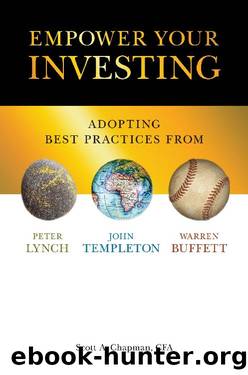Empower Your Investing by Scott A. Chapman CFA

Author:Scott A. Chapman CFA [Chapman, Scott A.]
Language: eng
Format: epub
Publisher: Post Hill Press
Published: 2019-06-21T16:03:20+00:00
33 United States of America Financial Crisis Inquiry Commission Interview of Warren Buffett, May 26, 2010.
34 Dow Jones News, âBillionaire Buffett Takes a Swipe at Trust Fund Kids,â October 3, 2000.
CHAPTER 19
Evolution of Buffettâs Stock Selection Method
Weâre adapting reasonably to a business thatâs gotten very much more difficult.
âCharlie Munger1
The last chapter discussed the influences on Warren Buffettâs stock picking philosophy. This chapter explores the evolution of Buffettâs investing style. His investments followed three distinct phases:
1. Early Buffett: Mediocre smaller companies bought at bargain âcigar-buttâ prices in the classic style of Benjamin Graham, which emphasized buying companies priced at a discount to tangible assets on the balance sheet. Graham had his limitations. In 1988 Buffett told Fortune magazine columnist Carol Loomis, âBoy, if I had listened only to Ben, would I ever be a lot poorer.â Buffett conceded at the 1996 Berkshire Hathaway annual meeting that one of his biggest mistakes was not paying up for quality businesses.
2. Later Buffett: Quality businesses, in the style of Charlie Munger, Phil Fisher, and Phil Carret, which were not selling at prices related to tangible assets, but were attractively priced relative to their future earnings power based on a qualitative assessment of the durability of a companyâs competitive advantages. In Buffettâs terminology, he assessed whether the companyâs âcastleâ was surrounded by a wide protective moat and whether the companyâs product had pricing power. These companies typically generated high returns on capital (ROIC) and required little incremental capital to grow.
The principles of buying value and margin of safety and the detachment from the market I learned from Ben. You might say that I learned the proper temperamental set from Ben. The stocks I buy are entirely different from what Ben would buy if he were alive today.2
Buffett also believed that Ben Grahamâs method wouldnât scale with large sums of money at Berkshire.
During this period, Buffett evolved toward Charlie Mungerâs influence of buying excellence; especially companies with strong brand loyalty and pricing power. Often these brands were much more valuable than their tangible assets, but the value of their intangible brand didnât appear on their balance sheet. Graham relied on quantitative bargains based on tangible assets, and Buffett transitioned to quantitative bargains based on future cash flows. Graham had no interest in predicting earnings because he didnât have confidence about those predictions. Unlike Buffett, Graham followed Yogi Berraâs advice that it is tough to make predictions, especially about the future. Fortunately, Buffett was a fan of another baseball hall of famer, Ted Williams, who advised to wait for the right pitch. Buffett said âwe mostly buy stocks for future earnings3â and those stocks have to be a fat pitch. Otherwise, he will stand with the bat on his shoulder.
3. Modern Buffett: Large, capital-intensive companies with stable, recession-resistant returns in the mature Berkshire phase. Warren Buffett admitted that:
You canât expect to get returns in the utility business (that you get in other businesses). Itâs not a great business; itâs a good business. And the more money we can put in good businesses, the better I like it.
Download
This site does not store any files on its server. We only index and link to content provided by other sites. Please contact the content providers to delete copyright contents if any and email us, we'll remove relevant links or contents immediately.
Rich Dad Poor Dad by Robert T. Kiyosaki(6414)
Pioneering Portfolio Management by David F. Swensen(6230)
How To Win Friends and Influence People by Dale Carnegie(4447)
The Money Culture by Michael Lewis(4083)
The Dhandho Investor by Mohnish Pabrai(3706)
The Wisdom of Finance by Mihir Desai(3659)
Liar's Poker by Michael Lewis(3372)
Fooled by Randomness: The Hidden Role of Chance in Life and in the Markets by Nassim Nicholas Taleb(3050)
The ONE Thing by Gary Keller(3015)
The Intelligent Investor by Benjamin Graham Jason Zweig(2996)
Mastering Bitcoin: Programming the Open Blockchain by Andreas M. Antonopoulos(2983)
Rich Dad Poor Dad: What The Rich Teach Their Kids About Money - That The Poor And Middle Class Do Not! by Robert T. Kiyosaki(2910)
How to Day Trade for a Living: Tools, Tactics, Money Management, Discipline and Trading Psychology by Andrew Aziz(2909)
Investing For Dummies by Eric Tyson(2895)
How to Win Friends and Influence People by Dale Carnegie(2864)
Market Wizards by Jack D. Schwager(2645)
The Psychology of Money by Morgan Housel(2635)
Zero Hour by Harry S. Dent Jr. & Andrew Pancholi(2614)
How to Pay Zero Taxes, 2018 by Jeff A. Schnepper(2604)
